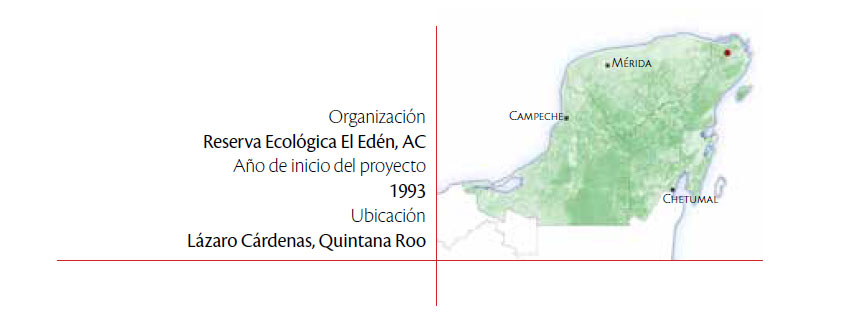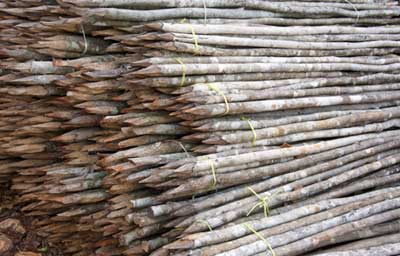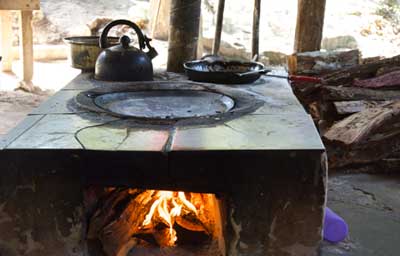Reserva Ecológica El Edén y una visión de conectividad de los ecosistemas
 Introducción La Reserva Ecológica El Edén fue creada en el año 1993, convirtiéndose de esa manera en la primera reserva privada dedicada a la investigación y conservación de la biodiversidad en México. Ese fue el inicio de un camino repleto de desafíos inesperados, pero también de logros que mantuvieron la motivación en lo que alguna vez fue el sueño de un grupo de investigadores y conservacionistas, entre ellos el reconocido especialista en etnobotánica Dr. Arturo Gómez Pompa. El propósito fundamental de la reserva inicialmente fue demostrar que la sociedad civil puede hacer conservación y destinar espacios a un uso de investigación y educación, lo que a través del tiempo se fue consolidando en una masa crítica de investigadores e información técnica de utilidad para la conservación y manejo de recursos naturales a escala regional. El Edén comenzó con una superficie de 900 hectáreas que fue aumentando en diferentes etapas. Hoy la reserva cuenta con 3,000 hectáreas, y espera poder llegar a 4,500 en el corto plazo. Pero reto mayor es mantener la conectividad ecosistémica de la región tomando al jaguar como objetivo primordial de conservación, y para eso es necesario ampliar la visión más allá de los límites de la reserva, y generar alianzas con propietarios de tierras y con otras reservas de carácter público o privado. A finales de la década de 1980, el Dr. Arturo Gómez Pompa y el biólogo Marco Lazcano sobrevolaron por primera vez el norte de Quintana Roo. El propósito era identificar sitios prioritarios para la conservación de humedales, y Marco estaba particularmente interesado en la conservación de cocodrilos. Luego de ese primer sobrevuelo hubo un incendio de gran magnitud en el norte de Quintana Roo, por lo que Gómez Pompa fue invitado a sobrevolar nuevamente la zona para evaluar el estatus en el que quedaron los ecosistemas, y en ese vuelo también participó Marco. Después de esos dos sobrevuelos, los investigadores percibieron que la zona era inmensa, se encontraba muy bien conservada y con ecosistemas diferentes a lo que se conocía en el resto del país. Pudieron ver desde el aire humedales de forma lineal en sentido norte sur, siguiendo la falla de Holbox, entrelazados con selvas, cenotes y cavernas que no eran comunes incluso en la península. Arturo y Marco sabían de la fragilidad de los ecosistemas, que la frontera agropecuaria comenzaba a acelerarse y también crecía muy cerca uno de los mayores polos turísticos del mundo. El tiempo comenzaba a correr por esos años, el desafío era enorme pero también lo era el sueño por conservar ese tesoro de la biodiversidad, un verdadero edén. Una vez compradas las primeras 900 hectáreas de la reserva, uno de los momentos más relevantes para El Edén fue en 1994, año en que se logró contar con la infraestructura para una estación biológica formal, y eso permitió comenzar a invitar a investigadores a utilizar el predio, brindar cursos de capacitación y formar recursos humanos para construir un sistema de información sobre los recursos de la reserva. El año 1996 fue otro momento clave, cuenta Marco, porque hubo un incendio forestal grande que obligó a iniciar un camino de aprendizaje para la protección de la vegetación y la infraestructura, no solo desde el punto de vista técnico de vigilancia y combate de incendios, sino también de la coordinación con instancias de gobierno y vecinos de la reserva. Comenzar a estudiar los jaguares también marcó un hito para la reserva, pero fue un proceso en el tiempo más que un momento en la historia de El Edén. Desde un inicio, Marco se focalizó en el estudio de cocodrilos de una manera diferente a la convencional, ya que comenzó a identificar individuos y nidos a los que se podía dar seguimiento en el tiempo. La ventaja que brindaba la reserva por contar con un ecosistema de poblaciones estables de fauna incentivó a los investigadores iniciar el estudio de otros grupos de animales. Comenzaron por colocar cámaras de video que dejaban filmando durante horas para luego revisar si algún mamífero pasó por el área. En el año 2005, con la incorporación de la tecnología de las cámaras trampa, se logra fotografiar a un primer jaguar, y tres días más tarde a un puma que pasó por el mismo lugar. “Esto nos incentivó mucho, cuenta Marco, porque era la evidencia de que pumas y jaguares compartían territorio”. El 2005 fue un año clave, por un lado la reserva recibe un reconocimiento nacional a la conservación por su trayectoria, y por otra parte con la incorporación de las cámaras trampa se pasa de documentar rastros y huellas a identificar individuos por su patrón de manchas. Esto permitió registrar cuatro jaguares diferentes en un período de tres meses, en el mismo sitio y con una sola cámara. Eso dio la pauta de que la población de jaguares podría ser grande, lo cual llevó a establecer vínculos con otros investigadores para tener una mayor aproximación a escala regional. El intercambio de información con otras reservas permitió reconocer que un individuo fotografiado en El Edén en el año 2006 era el mismo que había sido fotografiado por Pronatura en El Zapotal en 2004, con 50 km de distancia entre sí y con una carretera que atravesar.
En 2008, el Instituto de Ecología de la UNAM invitó a El Edén para que formara parte del primer Censo Nacional del Jaguar, y de esa manera se realiza la primera estimación de población en la reserva que efectivamente fue alta, seis jaguares en un área de 100 km2. Pero las fotos logradas brindaron más información aún, ya que la primera imagen obtenida fue de una hembra y un macho caminando juntos, y esta era la evidencia de que en el área había eventos reproductivos. El hecho de que la reserva sea un sitio de reproducción llevó a generar un planteamiento de conectividad para garantizar el intercambio genético de las poblaciones de jaguar. Por esa razón, en el año 2007 se inicia un trabajo conjunto con diferentes actores como Pronatura Península de Yucatán, Amigos de Sian Ka’an, Biocenosis, ONCA Maya, el Centro de Investigaciones del Trópico de la Universidad Veracruzana (CITRO), CONAFOR, Unidos para la Conservación y la Universidad Autónoma de Tabasco. Con la información que reunían entre todos se diseñó un primer mapa de la Península de Yucatán, con la ubicación de las áreas importantes para la conservación del jaguar y los escenarios de posibles corredores biológicos. “Con esto nos dimos cuenta que para lograr la permanencia en el tiempo de las poblaciones en El Edén, la estrategia de conservación tiene que ser a un nivel más amplio”, explica Marco. La estrategia de conservación de El Edén se enfoca a nivel regional en el centro norte de Quintana Roo, y eso implica identificar claramente las unidades de conservación que todavía conservan vegetación suficiente para mantener una población de al menos 250 o 300 jaguares, que es lo que se estima para esa zona. Es muy importante trabajar en la conectividad de esta región, dice Marco, porque hoy sabemos que en la Península de Yucatán hay alrededor de 2,000 jaguares, prácticamente el 50% de la población del país, y es fundamental mantener la viabilidad genética en el tiempo. En el año 2009, el Área de Protección de Flora y Fauna Yum Balam obtuvo una foto del mismo jaguar que había sido documentado en El Zapotal en 2004 y en El Edén en 2006. En los años 2010 y 2011, El Edén vuelve a documentar el mismo jaguar, con lo que se reunió la suficiente evidencia de que ese individuo tiene una permanencia en la zona de al menos siete años, y el área de ocupación coincide con las identificadas como prioritarias en los mapas que fueron generados en 2007. Posterior a esto, El Edén junto con los investigadores Cuauhtémoc Chávez y Sandra Ortiz de la UNAM, colocaron un collar satelital a un jaguar del que se obtuvo información durante 16 meses, pudiéndose comprobar que este individuo se desplazó 60 km de este a oeste, y 25 km en el sentido norte sur. Con toda la información reunida hasta hoy, dice Marco, lo que sabemos es que contamos con una unidad funcional de ecosistemas continuos para la conservación del jaguar, sabemos que los individuos están ahí y lo están utilizando. “Establecer una reserva privada ha sido un gran reto, cuenta Marco, un proceso complicado de aprendizaje, de obtener recursos, de construir capacidad. Lo hemos logrado gracias a que ha sido un sueño conjunto de varias personas que trabajamos incluso antes de tener El Edén. Aunque contamos con convenios y financiamiento de distintas fuentes, hoy todavía no tenemos un recurso garantizado en el largo plazo, pero estamos en un punto crucial porque, a diferencia de cuando empezamos, hoy se reconoce el valor de la diversidad biológica sobre una propiedad”. Según la visión de Marco, hoy empieza a haber mecanismos que permiten en términos financieros dedicar tierras a conservación, como es el caso del Pago por Servicios Ambientales (PSA). El gran reto es lograr que esos esquemas de PSA se mantengan en el largo plazo, y que existan otros incentivos para propietarios y poseedores de predios que destinan tierras de manera voluntaria para la conservación, porque la viabilidad de los ecosistemas depende de la conectividad y el intercambio genético de sus poblaciones, y esa escala es mucho más amplia que los límites de una reserva. |




















